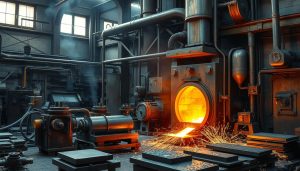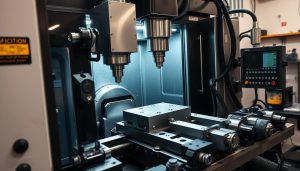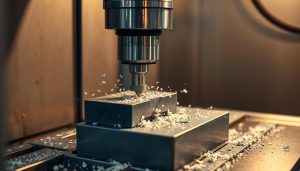In the world of engineering and manufacturing, the strength of materials is a critical factor that directly impacts the performance, durability, and safety of a wide range of products. Among the various materials used in these industries, metals stand out as a versatile and widely-utilized choice. Understanding the concept of metal strength and its importance in material selection is essential for engineers, designers, and industry professionals who strive to create reliable and innovative solutions.
Metal strength is a fundamental property that determines a material’s ability to withstand various types of loads, stresses, and forces. It encompasses several key characteristics, such as yield strength, tensile strength, compressive strength, and impact resistance. These attributes play a crucial role in determining the suitability of a metal for specific applications, from aerospace components to automotive structures and construction materials.
What is Metal Strength?
Metal strength is a crucial factor in material selection and engineering design. It is a measure of a metal’s ability to withstand various forms of stress and deformation without failing or losing its structural integrity. Understanding the different types of metal strength is essential for selecting the right materials for diverse applications.
Definition and Importance of Metal Strength
Metal strength can be defined as the resistance of a metal to various types of stress, including tensile, compressive, and shear forces. It is a fundamental property that determines a metal’s suitability for specific use cases, such as in the construction of buildings, vehicles, or aerospace components. The strength of a metal is a critical consideration in ensuring the safety, reliability, and longevity of these structures and products.
Types of Metal Strength: Yield, Tensile, Compressive, and Impact
- Yield Strength: The point at which a metal begins to deform permanently under stress, beyond which it will not return to its original shape.
- Tensile Strength: The maximum stress a metal can withstand before it breaks or fractures when pulled apart.
- Compressive Strength: The ability of a metal to resist being compressed or crushed under an applied force.
- Impact Strength: The measure of a metal’s resistance to sudden, high-energy impacts or shocks, such as those experienced in a collision or accident.
Each type of metal strength plays a crucial role in determining the overall performance and suitability of a material for specific applications. Engineers and material scientists carefully analyze these strength characteristics to ensure the optimal selection and design of metal components.
| Type of Metal Strength | Definition | Significance |
|---|---|---|
| Yield Strength | The point at which a metal begins to deform permanently under stress, beyond which it will not return to its original shape. | Crucial for applications where the metal must maintain its shape and structural integrity under load. |
| Tensile Strength | The maximum stress a metal can withstand before it breaks or fractures when pulled apart. | Determines the metal’s ability to resist failure and ensures the safety and durability of components. |
| Compressive Strength | The ability of a metal to resist being compressed or crushed under an applied force. | Critical for materials used in load-bearing structures, such as columns and foundations. |
| Impact Strength | The measure of a metal’s resistance to sudden, high-energy impacts or shocks. | Vital for components that may be subjected to sudden, dynamic loads, like in automotive and aerospace applications. |
“The strength of a metal is a crucial factor in ensuring the safety, reliability, and longevity of the structures and products they are used in.”
Measuring Metal Strength
Accurately measuring metal strength is crucial for engineers and material scientists. A range of standard tests are employed to determine the various aspects of metal strength, including yield strength, tensile strength, compressive strength, and impact resistance. These metal strength testing methods provide the essential data points that guide engineering design and material selection decisions.
Standard Tests for Determining Metal Strength
The most common material testing methods used to assess metal strength include:
- Tensile testing: Measures a material’s resistance to being pulled apart.
- Hardness testing: Evaluates a material’s resistance to indentation or scratching.
- Impact testing: Determines a material’s ability to withstand sudden, high-force impacts.
- Fatigue testing: Assesses a material’s resistance to failure under cyclic loading conditions.
These standardized tests provide quantifiable data on a metal’s engineering data analysis, which allows engineers to select the appropriate materials for their applications based on the required strength characteristics.
How Engineers Use Metal Strength Data
Engineers rely on the comprehensive metal strength testing data obtained from these standard tests to make informed decisions during the design and manufacturing process. By understanding a material’s yield strength, tensile strength, and other key properties, they can ensure the structural integrity and safety of their products, whether in the aerospace, automotive, or construction industries.
| Test Type | Measured Property | Typical Applications |
|---|---|---|
| Tensile Testing | Tensile Strength, Yield Strength | Structural Components, Fasteners, Springs |
| Hardness Testing | Hardness | Cutting Tools, Bearings, Wear-Resistant Parts |
| Impact Testing | Impact Resistance | Automotive Safety Parts, Construction Materials |
By carefully analyzing the metal strength testing data, engineers can optimize their designs, ensure product reliability, and meet the performance requirements of their respective industries.
“Accurate measurement of metal strength is the foundation of reliable engineering.”
Factors Affecting Metal Strength
Metal strength is a complex and multifaceted property that is influenced by a variety of factors. From the metal composition and alloying elements to the environmental factors and metal processing techniques, these elements all play a crucial role in determining the overall strength of a metal. Understanding these factors is essential for engineers and manufacturers to optimize the performance of their metal components.
Material Composition and Alloying
The metal composition and the presence of alloying elements can significantly impact the strength of a metal. The addition of certain elements, such as carbon, chromium, or nickel, can enhance the metal’s resistance to deformation and fracture, making it stronger and more durable. Careful control over the metal’s chemical composition is crucial for achieving the desired strength characteristics.
Temperature, Environment, and Processing Techniques
The environmental factors surrounding the metal, including temperature and exposure to various elements, can also influence its strength. Extreme temperatures, whether high or low, can alter the metal’s microstructure and, consequently, its strength. Similarly, the metal processing techniques employed, such as heat treatment, cold working, or hot rolling, can significantly affect the metal’s strength by modifying its internal structure and properties.
Strain Rate and Load Conditions
The strain rate and the type of load applied to the metal can also have a significant impact on its strength. Metals can exhibit different strength characteristics when subjected to high-speed impacts, slow-moving loads, or cyclic stresses. Understanding the load conditions that the metal will experience in its intended application is essential for selecting the appropriate material and design to ensure optimal performance and safety.

“The strength of a metal is not a fixed property, but rather a dynamic characteristic that can be tailored to meet the specific needs of an application.”
By carefully considering these factors, engineers and manufacturers can optimize the metal strength for their specific applications, ensuring superior performance and reliability.
Applications of Metal Strength in Various Industries
Metal strength is a critical factor in numerous industries, from aerospace to automotive and beyond. The superior strength-to-weight ratios and durability of high-performance metals make them invaluable in a wide range of applications that demand exceptional performance and reliability.
Aerospace: Strength for Lightweight Components
In the aerospace industry, metal strength is paramount. Lightweight yet strong aerospace materials like titanium and advanced aluminum alloys are essential for constructing aircraft components that must withstand immense stresses while maintaining fuel efficiency. Manufacturers leverage the exceptional strength properties of these metals to create innovative, high-performance airframes, engine parts, and other critical systems.
Automotive: Ensuring Safety and Durability
The automotive industry relies heavily on strong automotive safety materials to protect drivers and passengers. Automakers utilize high-strength steel, aluminum, and other alloys to create robust vehicle frames, crumple zones, and other safety-critical components. These metals’ ability to absorb impact energy and maintain structural integrity is crucial for protecting occupants in the event of a collision.
Manufacturing and Construction: Structural Integrity
Metal strength is also a vital consideration in construction materials and various manufacturing processes. Builders and manufacturers leverage the exceptional strength of metals like steel to create sturdy, long-lasting structures and industrial equipment. The ability of these materials to withstand high loads, resist corrosion, and maintain their integrity under demanding conditions makes them indispensable for applications ranging from skyscrapers to heavy machinery.
Across a diverse range of industries, the remarkable strength properties of metals continue to drive innovation and enable the creation of safer, more durable, and more efficient products and structures. As technology advances, the role of metal strength in shaping the future of various sectors will only continue to grow.

Common Metals and Their Strength Characteristics
When it comes to industrial applications, the strength of metals plays a crucial role in material selection. Three of the most commonly used metals, each with its unique strength properties, are steel, aluminum, and titanium. Let’s explore the strengths and applications of these versatile materials.
Steel: The Strong Backbone of Industry
Steel is renowned for its exceptional strength and durability, making it a staple in various industries. Its high tensile strength and yield strength make it an ideal choice for structural components, machinery, and infrastructure. Steel’s compressive strength and impact resistance also contribute to its widespread use in the automotive and construction sectors.
Aluminum: Lightweight yet Strong
While not as strong as steel, aluminum alloys offer a unique combination of lightweight and strength. Aluminum’s low density and high strength-to-weight ratio make it a popular choice for aerospace, transportation, and consumer electronics applications. Its corrosion resistance and ease of fabrication further enhance its appeal in these industries.
Titanium: High Strength-to-Weight Ratio
Titanium is a remarkable metal known for its exceptional strength-to-weight ratio. Its high tensile strength and excellent resistance to corrosion make it a preferred material for aerospace, medical implants, and high-performance applications. Titanium’s unique properties allow for the design of lightweight, durable, and long-lasting components.
When it comes to metal strength, the choice between steel, aluminum, and titanium often depends on the specific requirements of the application, balancing factors such as weight, strength, and cost. Understanding the unique characteristics of these common metals is crucial for engineers and designers to make informed decisions in various industries.
Shixinproto’s CNC Machining Services for High-Strength Materials
At Shixinproto, we understand the critical role that high-strength materials play in modern industrial applications. As a leading provider of CNC machining services, we are dedicated to delivering precision-engineered solutions that leverage the power of robust alloys to meet our clients’ most demanding requirements.
Precision Machining of Strong Alloys for Industrial Applications
Our state-of-the-art CNC machining capabilities enable us to process a wide range of high-strength materials, including steel, titanium, and specialized alloys, with unparalleled accuracy and efficiency. Whether you require intricate components for aerospace, automotive, or manufacturing sectors, our team of skilled technicians ensures that every part we produce meets the most stringent quality standards.
Custom Solutions for Metal Strength in Prototyping and Production
At Shixinproto, we recognize that each project is unique, with its own set of challenges and requirements. That’s why we offer custom metal solutions tailored to your specific needs, whether you’re in the prototyping or production stage. Our experienced engineers work closely with you to understand your project’s objectives and deliver innovative, high-strength designs that push the boundaries of what’s possible.
FAQ
What is metal strength, and why is it important?
What are the different types of metal strength?
- Yield Strength: The stress at which a metal begins to deform plastically.
- Tensile Strength: The maximum stress a metal can withstand before breaking or failing.
- Compressive Strength: The ability of a metal to resist being compressed or crushed.
- Impact Strength: The ability of a metal to absorb energy and resist fracture under sudden, high-force impacts.
How is metal strength measured and tested?
What factors influence metal strength?
- Material composition and alloying
- Temperature and environmental conditions
- Processing techniques, such as heat treatment or cold working
- Strain rate and load conditions
How is metal strength used in different industries?
- Aerospace: For lightweight, high-strength components
- Automotive: To ensure safety and durability
- Manufacturing and Construction: To provide structural integrity
What are some common high-strength metals, and how do they compare?
- Steel: The industrial backbone, known for its exceptional strength.
- Aluminum: Lightweight yet strong, with excellent strength-to-weight ratio.
- Titanium: Extremely strong and corrosion-resistant, with a high strength-to-weight ratio.





